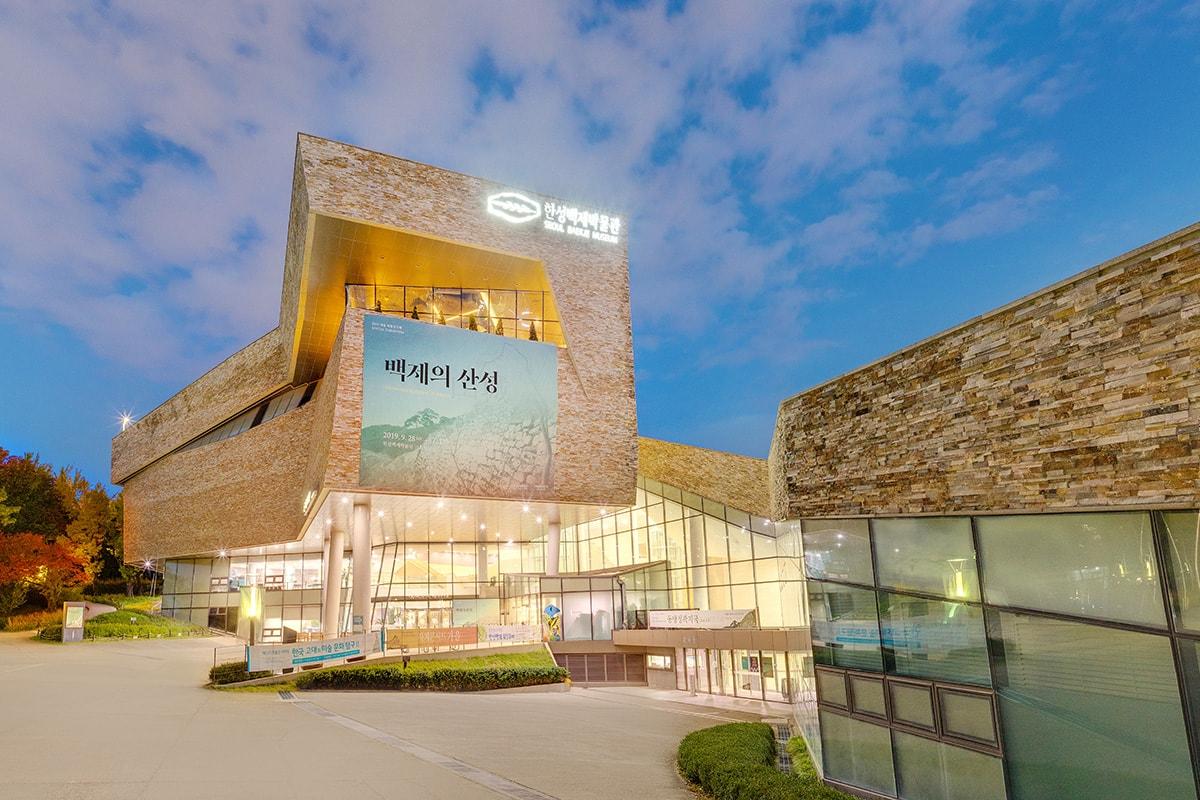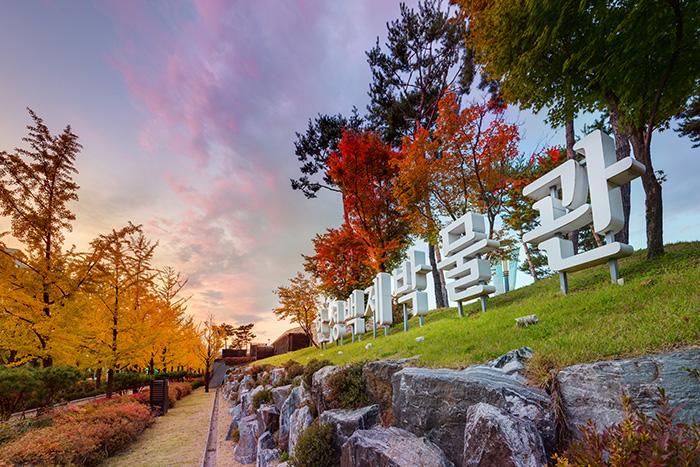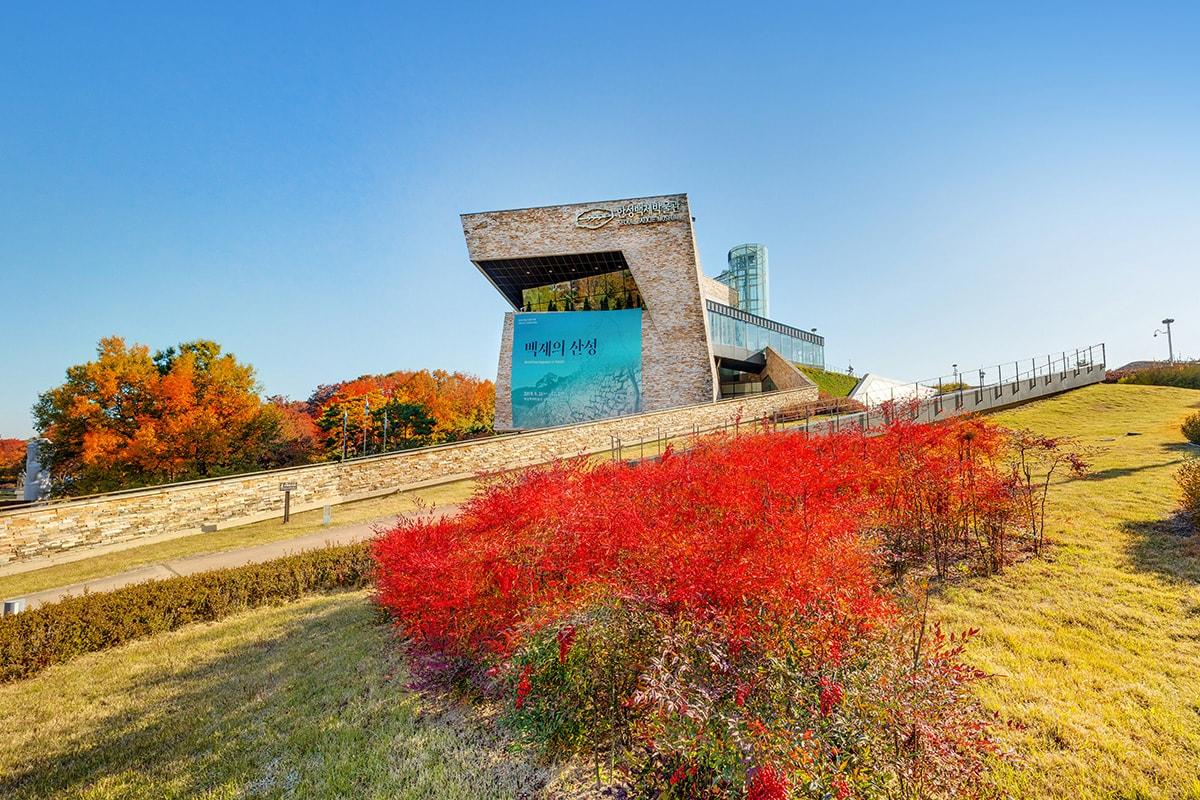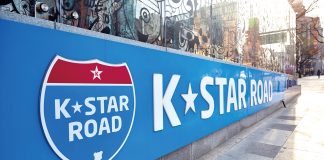Exploration of the culture of Baekje through its architecture
Seoul Baekje Museum
Yong-mi Kim | Republic of Korea

Baekje (18BCE–660CE), an ancient kingdom of Korea, had prospered while Hanseong (today’s Seoul) was its capital, thus the period was named the “Hanseong Baekje Era” (18BCE–475CE). Remnants of the kingdom can be seen at the Seoul Baekje Museum, which exhibits 2000+ year-old ancient cultural relics from the Kingdom as well as from East Asia.

The museum is located within the Olympic Park overlooking the Mongchontoseong Earthen Fortification, an important historical site built during the Hanseong Baekje era. Resembling a hill, the fortification was built by layering compacted earth such as strata, as can be seen from the scale model. Architect Yong-mi Kim used motifs found at the earthen fortification to design the Museum.
The site was originally a hill of pine trees. Kim constructed the museum on a slight hill while maintaining the original shape of it. She saved the height and erected fortress-like walls around it, then dug under the hill to build a lobby inside. The deep and spacious area with no pillars, receives plenty of sunlight through the skylight. The interior structure is reminiscent of an ancient pit-dwelling. In addition, the museum was designed with a sloping roof so that people can walk over the roof. The path merges into pathways and trails of the Olympic Park, naturally connecting the museum to the park. The Mongchontoseong Earthen Fortification can be seen atop the highest point on the museum’s roof.


Upon entering the museum, a replica of the fortress’ cross section can be seen a wall. This gigantic structure standing at ground level is three-stories high, mesmerizing visitors with its grand scale.

TIP
Every fall, the Hanseong Baekje Cultural Festival is held at historical sites of the ancient Baekje Kingdom (e.g., Pungnaptoseong & Mongchontoseong Earthen Fortifications) near Lotte World. You can see memorial rituals for kings, and a parade themed on the history and culture of Baekje. Various eateries and food carts are operated during the event.
TOURIST ATTRACTIONSS
• Lotte World & Lotte World Tower
• Seoul Olympic Museum of Art (SOMA)
• Pungnaptoseong Earthen Fortification
Address
71 Wiryeseong-daero, Songpa-gu, Seoul
Way
5-min walk from Exit 2 of Hanseong Baekje Station, Subway Line 9
Tel
02-2152-5800
Admission
Free (except for special & planned exhibitions)
Website
baekjemuseum.seoul.go.kr
Time
09:00–19:00 (Closed on Mondays and Jan 1)
Architecture outlining the life of the artist
Yeocho Calligraphy Museum
Sung-kwan Lee | Republic of Korea

Yeocho Calligraphy Museum was built in commemoration of Eung-hyun Kim (1927–2007), who is considered the best calligrapher in Korea’s history. Yeocho, which translates to “same as the beginning,” was Kim’s penname. He lived a life dedicated to calligraphy. When he injured his right hand, he practiced calligraphy with his left hand and even held an exhibition with calligraphy pieces he created using his left hand.

Sung-kwan Lee, who designed the museum, studied Kim’s work in depth and tried to reflect the grace and elegance of the artwork in the museum. Lee paid attention to the old pine tree forest surrounding the museum’s site. In Korea, pine trees symbolize the grace and upright character of Confucian scholars. Lee wanted to embrace the pine tree forest in the museum layout to accentuate and complement Kim’s artwork. Based on this design concept, the museum’s layout does not interfere with the natural landscape and preserves the pine forest.


The architect built the educational and annex buildings on the hillside and all the buildings were raised on pilotis. Due to the void formed on the ground level, the museum looks as if it were part of nature, even more so when viewed up close. Upon entering the museum, visitors are welcomed by a square opening on the ceiling offering great views of the sky, and an artificial pond reflecting the glistening sun. The pond, filled with water drawn from a nearby stream, reflects the natural scenery as well as the calligraphy of Eung-hyun Kim, which is engraved on the museum’s exterior.

TIP
Not far from the museum sits Seoraksan Mountain, a national park, natural monument (designated in 1965), and UNESCO Biosphere Reserve (designated in 1982). The mountain boasts superb landscapes and has several time-honored Buddhist temples, such as Baekdamsa and Sinheungsa Temples.
TOURIST ATTRACTIONS
• Korean Poetry Museum
• Yongdae-ri Hwangtae Village
• Seoraksan National Park (Baekdamsa & Sinheungsa Temples)
Address
154 Manhae-ro, Buk-myeon, Inje-gun, Gangwon-do
Way
Taxi (5mins) from Baekdam Intercity Bus Terminal
Tel
033-461-4081
Admission
Free
Website
yeochomuseum.kr
Time
09:00–18:00 (Closed on Mondays, Jan 1, and Seollal & Chuseok days)
Architecture that embodies the shape and sound of a Korean Buddhist bell
Jincheon Bell Museum
Gue-seok Kim | Republic of Korea

Home to the oldest steel production site in Korea, Jincheon has produced steel through smelting, tempering, and forging since the 3rd century to the 5th century. The Jincheon Bell Museum exhibits quality bells collected from home and abroad as well as Buddhist bells that were made using ancient steel production techniques.
When architect Gue-seok Kim designed the Jincheon Bell Museum, he was inspired by the Korean Buddhist bell, which makes a magnificent yet gentle sound. The architect’s intentions can be seen from the structure. First, by the museum entrance is a glass structure that is a reproduction of a Buddhist bell. When standing under it, you will hear the gentle ring of the bell arousing your curiosity towards the various other bells in the museum. The glass curtain wall on the right has a curved surface, which represents the beats created by the sound of the bells, explains the architect. In acoustics, a beat is an interference pattern between two sounds of slightly different frequencies, creating amplitude that changes regularly. Such a phenomenon is frequently found in Buddhist bells.

The first thing you see upon entering the museum is a life-sized replica of the Divine Bell of King Seongdeok, a representative Buddhist bell of Korea. Completed in 771 during the Unified Silla era, the original bell is exhibited at the Gyeongju National Museum. This grandiose replica stands 3.33 meters tall with a diameter of 2.27 meters on a two-story high space, and above the bell is a large sculpture that portrays the moment when the Buddhist Bell was taken out of the formwork after the molten metal was cast.
The Jincheon Bell Museum exhibits various types of Buddhist bells and their manufacturing process. The nine-step manufacturing process—including melting beeswax in an iron cast pot, carving design patterns, and pouring molten metal—is exhibited in the museum so that visitors can easily understand how a Buddhist bell is made.


The Jincheon Bell Museum exhibits various types of Buddhist bells and their manufacturing process. The nine-step manufacturing process—including melting beeswax in an iron cast pot, carving design patterns, and pouring molten metal—is exhibited in the museum so that visitors can easily understand how a Buddhist bell is made.


















![[A ZONE] Gangnam Food Spot](https://m.dgram.co.kr/wp-content/uploads/2020/09/A존-알래스카3-특성이미지_S-324x160.jpg)
![[A ZONE] Gangnam Life Style](https://m.dgram.co.kr/wp-content/uploads/2020/09/로우클래식1-특성이미지_S-324x160.jpg)




